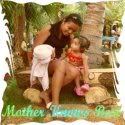She's a Big Kid Now
My child's physical growth is starting to slow down as she nears her third birthday, but she's getting leaner and faster and more coordinated -- she can sweep the floor, catch a ball, build taller block towers, and even knows how to wash clothes and can grip pens and crayons and write on her own.
As her motor skills improve, she's also increasingly, joyously confident in her play. "Don't be surprised if your child high-fives you as he/she learns new things and becomes more independent."
Here's what I've learned:
Let's Play
Play truly is a child's work. When children engage in physical activity at this age, they improve their strength, endurance, and balance. Games with others help 2-year-olds build language skills and offer a way into the adult world of social rules. Meanwhile, your child's solo investigations into nature, music, and math can teach her about how the world works -- like how some things float while others sink, and how music can affect mood.
Your child has been engaging in symbolic play for months, using toys and dolls to act out events. As she nears her third birthday, "pretend play becomes more sophisticated," and you'll see your child mix and match her props. "She may take a doll from one play set and mix it in with her building blocks, then walk that doll down a staircase made of blocks to get into a toy car."
A Whole
In this new, revved-up fantasy life, your child can be a scary lion or a tender mother, a bossy queen or a baby, all while safely working out her emotional life and satisfying her curiosity about why people do things the way they do. Through imaginary play, kids have a chance to take on other points of view and mull over complex emotional issues too.
It's great fun to watch your child's imagination take fire as he rides a mop that has become a horse, serves a dinner made of grass and twig soup, or rides to the moon in a cardboard box. This burning imagination can sometimes result in unique (and occasionally comic) theories about how the world works. By now, your child observer understands certain things because he's seen them with his own eyes, like "the mailman always puts the letters in the mailbox after breakfast." However, for many inexplicable things about the world, like the rainbow over the river after the rainstorm, the explanation may be "magic" -- or your child might concoct stories of his own.
"A monster growled under my bed," she may insist, when explaining why she wants to sleep with you. Or, when you confront him about that broken lamp in the living room, he may claim that he didn't break it even if he was the only one in the room.
Fibs and White Lies
Why do children this age invent stories or even blatantly lie? Mostly, it's because they still have trouble sorting out fantasy from reality. For example, between the ages of 2 and 3, many children engage in "animistic" thinking, believing that inanimate objects are actually alive. "They think the trees are waving their arms, or the table can walk because it has clawed feet." You have to remember that their reality is not your reality.
We adults are partly to blame for this, of course. We tell our children stories about wolves eating grandmothers and men in red suits scrambling down chimneys to put gifts under a tree. What's real and what's not? The boundaries aren't that clear yet, and won't be "until children are 4 or 5" .
Self-Centered Thinking
In addition, "young children usually focus on specific events that are the most important to them and ignore the stuff that isn't". For example, you may have spent an entire week at
Your child eventually outgrows this self-centered stage and will soon learn to tell the difference between real and imagined events. Meanwhile, revel in your little one's make-believe games, because research shows that children who engage in them are more content, self-aware, verbal, sensitive, and socially adept than those who do not.
Fair Treatment and Ownership
What you will also find is that children this age have short memories. When your little girl snatches that red bucket back from her friend and shouts, "Mine!" she may really believe that the bucket belongs to her -- even if she's the one who stole it in the first place. However, when you talk about it with her, your child's budding sense of fair play might kick in and she'll agree to take turns with the bucket.
The flip side is that your child is much more acutely, noisily, and sometimes comically apt to declare that she's been shortchanged. Pour the same amount of juice into two different cups for a pair of kids this age, and you may have a mutiny on your hands as one cries, "But he got more!"
A Changing Worldview
Each day, your child will demonstrate a better working knowledge of the world. One of the clearest signs of this is increased spatial awareness. Ask your 2-year-old to get the toy car he rolled under the table, for instance, and he'll crouch low instead of trying to walk straight under the table and hitting his head.
At age 2, children start learning the most fundamental spatial concepts first, like "on" and "in." They get a lot of practice with these ideas, putting objects "in" containers and watching Mom put dinner "on" the table. At this age, your child will describe an object in relation to a single landmark -- like "the ball is under the tree."
Naturally, what children learn about space and the position of objects by 33 months depends on what caregivers teach them. For instance, saying, "Let's put the plates on the table," or, "Now let's put the crayons in the container," helps a child grasp the language and the concepts involved.
What Your Child's Doing
Month 31
- Recognizes and draws a circle or a simple cross
- Runs smoothly
- Jumps off one step
Month 32
- Recognizes everyday sounds
- Kicks a ball forward
- Can match shapes and colors
Month 33
- Can answer the question: "Are you a boy or a girl?"
- Pedals a small tricycle
- Is able to dress and feed himself with help



















No comments:
Post a Comment